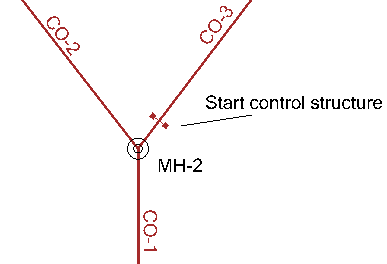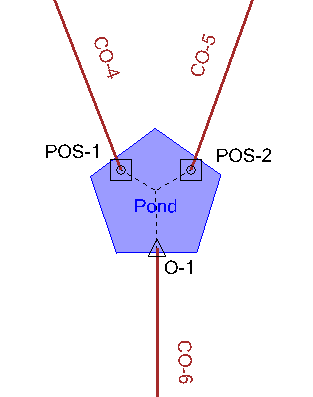| Product(s): |
SewerGEMS, CivilStorm |
| Version(s): |
08.11.XX.XX and higher |
| Area: |
Modeling |
Problem
When using the Implicit or Explicit (SWMM) numerical solver, how can I model a flow split / diversion, where a control structure such as a weir or orifice plate controls the split?
Solution
Using the Implicit or Explicit dynamic solver in SewerGEMS or CivilStorm, you can model a diversion as follows.
Note: if you are using the GVF-Convex (SewerCAD) or GVF-Rational (StormCAD) solver, a diversion rating curve needs to be used and you can find more guidance here: Modeling a flow split (diversion) with the SewerCAD or StormCAD numerical solver
Also see: Differences between solvers: GVF-Convex vs. GVF-Rational vs. Implicit vs. Explicit (SWMM)
1) Multiple conduits leaving a junction/manhole
In this case, the hydraulics of the flow split are controlled by the implicit solver based on the size and invert of the downstream pipes. Any small storage effects on the upstream side of the flow split can be modeled by way of the size of the manhole. Note that this also applies to pressure pipes and pressure junctions.

2) Conduit control structures
In this case, a weir or orifice can be modeled with a start control structure on the adjacent conduit(s). When doing this, the results may be unstable or very sensitive due to the relative large change in flow that tends to occur for a relatively small change in head with such control structures. So, you may need to use a very small calculation timestep, or use the Explicit (SWMM) solver with a small Routing Timestep (such as 1-5 seconds).
Note: for pressure pipes, a control structure cannot be modeled. So, if you have a gate valve that throttles flow to control the split, consider adding an additional short pressure pipe (by using the pressure junction layout tool to split an existing pipe) with a smaller diameter to model the restriction and resulting impact on flow split. See further below.

3) Pond with multiple outlets
In some situations, water may pond up at the upstream side of the flow split. In this case, a pond can be used to model the storage impact, and the diversion can be modeled with multiple pond outlet structures leaving that pond as seen below. The pond's elevation-area or elevation-volume table would be configured to represent the volume of the chamber that the flow diverts away from. If the chamber can become pressurized (surcharged from an enclosed top), consider adding a skinny "chimney" to the elevation-volume curve (tiny increase in volume for elevations above the physical top of the chamber, to allow surcharging without additional storage effects) as described in this article. This option may not work as well if the diversion chamber size is very small, as you will be more at risk for stability issues. You might need to use the Explicit (SWMM) solver with a one second Routing Timestep.
Note: if multiple culverts carry flow away from the split, you can use the headwall element instead of the pond outlet node, as described in this article: Modeling Reference - Headwalls


4) Multiple downstream channels, or multiple conduits (or culverts) leaving a channel
Similar to the first case above, you can use a cross section node instead of a manhole, to model multiple pipes or channels leaving a single upstream channel (such as a ditch). In the below example, three pipes leave a ditch:

If ponding occurs that you need to account for, or if you need to use the headwall element to model culvert inlets, consider the pond approach mentioned above.
5) Pressure pipe flow split
Flow can also split with pressure pipes (force mains) with the dynamic solvers. Note that a control structure cannot be modeled on pressure pipes. So, if you have a gate valve that throttles flow to control the split, consider adding an additional short pressure pipe (by using the pressure junction layout tool to split an existing pipe) with a smaller diameter to model the restriction and resulting impact on flow split.

See Also
Is it possible to model a weir within a catch basin or manhole in the the storm-sewer OpenFlows products?
Modeling a flow split (diversion) with the SewerCAD or StormCAD numerical solver
Troubleshooting unstable SewerGEMS and CivilStorm results using the implicit solver